



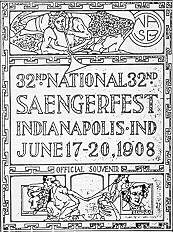
The tendency of German immigrants to settle in close proximity to each
other encouraged the
continuation of familiar lifestyles. Significant problems of
assimilation and adjustment were more
easily solved when at least some behavioral patterns of everyday life
could be retained, such as, shopping at a German
baker or butcher, and enjoying a beer in a German tavern or beer garden.
Likewise, if a German worked together with
Yankees and other immigrants, he much preferred to spend his free time
with his
fellow countrymen. This resulted in enterprising German-language
organizations that
encompassed all aspects of life, extending from the singing society to
the gymnastics club and all the way to the mutual aid society [early
forms of mutual health and funeral
insurance]. In colonial times already, especially in harbor cities
such as Philadelphia and New
York, well to-do Germans founded charitable institutions to better assist
newcomers. In the
middle of the nineteenth century, when the first wave of anti-immigrant
Nativism hit, there was a lot of discussion, even among German-Americans themselves,
concerning the positive and negative effects of the innumerable immigrant
organizations that were
operating at full tilt. Were they aiding or hindering integration? A
well-articulated contribution
to the debate was offered in 1857 by Atlantis, the top 1848er
journal:
Singing societies, theater clubs, Free Mason lodges,
political clubs of all parties,
and other organizations are found wherever Germans live, even in the
smaller cities. The
cultivating effects these societies have, however, are 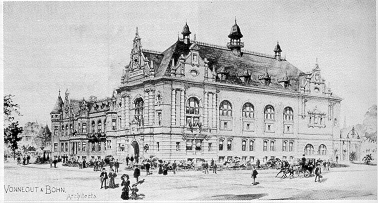 more than dubious
and,
in general, the observation is valid that these clubs degenerate to
the lowest possible levels of taste. They serve no other purpose than
pleasure, by which, however, they hang onto their
membership. Of course, many of these societies, especially
the musical groups, are a means to greater fellowship and they do build
bridges between
Americans and
Germans. The competitive singing festivals held in the East and the
West are welcome opportunities for good fellowship. . . . The first
attempt
at building an organized network of clubs extending all across the
Union was made by the Turner society, which from its earliest
initiatives showed promise for outstanding results in social and
political matters [Anonymous, "Das deutsche Leben in Amerika,"
Atlantis, Jan. 1857].
more than dubious
and,
in general, the observation is valid that these clubs degenerate to
the lowest possible levels of taste. They serve no other purpose than
pleasure, by which, however, they hang onto their
membership. Of course, many of these societies, especially
the musical groups, are a means to greater fellowship and they do build
bridges between
Americans and
Germans. The competitive singing festivals held in the East and the
West are welcome opportunities for good fellowship. . . . The first
attempt
at building an organized network of clubs extending all across the
Union was made by the Turner society, which from its earliest
initiatives showed promise for outstanding results in social and
political matters [Anonymous, "Das deutsche Leben in Amerika,"
Atlantis, Jan. 1857].
The value, especially of the Turner societies, for promoting
interaction between German
immigrants and English-speaking Americans, was articulated in 1886 by the
Chicago-based
socialist journal, Vorbote. The following editorial sharpens the
debate over
the admittance of English-language terminology for gymnastics training at the
Boston Turner society:
English commands, which should be used alongside German
commands only
when necessary, bring American  children onto the gymnastics field. Americans, teachers as
well as
others, can be won over to the cause of German gymnastics only if they
understand fully what's going on. At any rate, the case for our German
culture will be better served if
we attract Americans to our side. On the gymnastics field we can acquaint
them with our German
customs and traditions and, of course, also with our language more
successfully than if we hold them at bay because of our nationalistic
tendency to live in our
own enclaves. If gymnastics is such a good thing, then it is our civic
duty to make it accessible to
Americans as well" [Der Vorbote, July 7, 1886].
children onto the gymnastics field. Americans, teachers as
well as
others, can be won over to the cause of German gymnastics only if they
understand fully what's going on. At any rate, the case for our German
culture will be better served if
we attract Americans to our side. On the gymnastics field we can acquaint
them with our German
customs and traditions and, of course, also with our language more
successfully than if we hold them at bay because of our nationalistic
tendency to live in our
own enclaves. If gymnastics is such a good thing, then it is our civic
duty to make it accessible to
Americans as well" [Der Vorbote, July 7, 1886].

To what extent the Turner societies and other German-American social
clubs actually became
a venue for cultural exchange between Germans, Americans and other
immigrant groups has not
been thoroughly investigated. But if, for example, the history of the
Deutsches Haus-Athenaeum in Indianapolis has any representational value
for Turner clubs
elsewhere, we may hypothesize that a good deal of interaction took place
and continues to do so.
Besides the numerous
clubs
and the mutual
aid societies founded to meet the concrete needs and interests of members
locally, the
German-American National Alliance, a cultural-political umbrella
organization, was founded in Philadelphia in 1900. It got underway at a
time when German immigration
had dropped to a sixty-year low. The task of the Alliance was "to arouse
and promote feelings of
unity within the people of German origin." It was also designed "to spark
the inherent power of
the German-Americans so that they would exert a healthy
influence on, and an energetic defense of, such rightful wishes and
interests as were neither in
opposition to the common good of the country nor averse to the rights and
duties of good citizens
everywhere; to shield German-Americans against nativist attacks;
and to foster good, friendly relations between
America and the Fatherland."
The highest total membership the Alliance ever reported was three million
in 1916. Although
religious organizations tended to stay their distance, the at times
vociferous National Alliance
claimed to act as the "official" lobby of the German-Americans,
however defined. As if reacting on instinct, the Alliance opposed the
very notion of
prohibition as
well as all legislative attempts to enact it into law; it
fought against immigration limits; and it encouraged legislation that
would promote German language instruction in the public schools. At the
same time, the Alliance
encouraged the acquisition of American citizenship and along with that,
at least indirectly, the
learning of English and the study of the Immigration
Commission's citizenship "catechism." Intellectually, however, Alliance
leaders were not up to the challenge
presented by the First World War. On the one hand they propounded
arguments for
neutrality to the Wilson government, and on the other they engaged in
blatant pro-Kaiser
propaganda. Near the end of the war, the Alliance lost even its social
moorings, with the result
that, following Congressional hearings concerning its possible
un-American
activities, it was disbanded by government fiat.
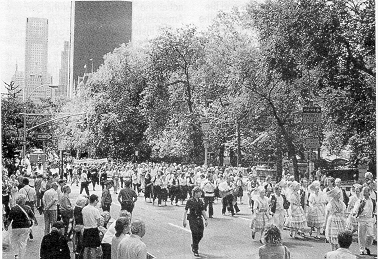
Founded in 1919 as a kind of replacement for the Alliance, the
Steuben Society of America
accepted into its membership only American citizens, used only English as
its official language,
and tried to distance itself from the former national
organization that had fallen into disrepute for its "unpatriotic" stand
on hyphenated Americanism.
It took until 1958 before the new society initiated its now popular
Steuben Parade in New York
City, an event which since has become a well publicized annual
festivity for German-Americans, including both local dignitaries as well
as visitors from abroad.
The Steuben Society's significance does not lie in the political arena.
Its existence and its activities
make sense rather as a symbolic statement, which
holds true also for the varied small social clubs all across America. In
other
words, many Americans are proud of their German heritage and maintain
memberships in a host
of organizations that range from the traditional "Männerchor,"
"Liederkranz," the "Swabian
Singing Society" and the "Brooklyn Schützen [sharpshooters] Choir"
to the New York Hanseatic Club for businessmen. Made wise through
unpleasant
experiences in the
past, the framers of constitutions and bylaws for these clubs usually
exclude any and all party
politics.
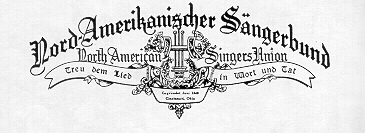
Many of the numerous local German-American clubs and societies, have
long passed their
100th or even 125th anniversaries. But due to the near cessation of
German immigration toward
the end of the 20th century, most German-American organizations have
difficulties recruiting the young for membership. The still growing
interest in "roots," however, has
led to the formation of regional German heritage societies where the
emphasis is less on
"Gemütlichkeit" and more on research and documentation.
Heritage societies take the notion of "German" in its ethno-linguistic or
cultural sense, which then
includes the heritage of all Americans whose roots reach back into the
German-speaking areas of
Europe.

The period for politically significant public displays of Germanness
ended for good with WW I
and the exile of Kaiser Wilhelm II in 1918. The celebration of the
Tricentennial of German
Immigration in 1983 gave rebirth to "October 6" as German-American
Day. It has taken its place among non-political festivities celebrated by
ethnic groups across the
United States. With good reason. There remains no trace of the
politically-charged German Day
which was celebrated in many cities from 1883 to 1933. Rivalries
with other immigrant groups and the struggle to win respect from Yankees
have long since passed
into history.
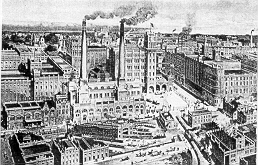
Quite a different mood prevailed in 1849, when the first
Sängerfest competition, held in
Cincinnati, publicly championed the strength and vitality of the Germans,
or even in 1900 in
Brooklyn, when over 6,000 singers from 174 singing societies poured
into the city for a Sängerfest lasting several days. In 1871, on
the occasion of the peace treaty
following the Franco-Prussian War and the founding of the German Empire,
the intentions that lay
behind the four-hour long parade of 100,000 people in Manhattan
were undeniably political. Commanded by Civil War general and
German-American hero,
Franz Sigel, all groups marched proudly: singers, Turners,
Schützenvereine [sharpshooters clubs],
old veteran groups, militia units, secret societies, lodges, brewers
, butchers and other trade union societies, charitable organizations,
reform clubs, citizens' groups
and school children. Large floats depicted among other themes and figures
the "Watch on the
Rhine," Gambrinus (the patron saint of beer),
a full-scale brewery, a coal mine, the crown of Charlemagne positioned
across the newly-united
Germany, and a retinue including the Kaiser with his crown prince (and
their escorts).
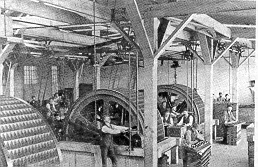
Festivals and parades that were occasioned by lesser historical
events, but organized by an
ethnic pride that has long since receded, were once perceived -- both
within the group and beyond it
by the general public -- as high points of ethnic array. The
reasons for celebrating were quite varied. There were Schützenfests,
Turnfests, Sängerfests,
Carnival parades, May celebrations, Johannis festivals [St. John the
Baptist Day coincides and is
celebrated with the summer solstice] -- all part of the observance of
annually repeated seasonal festivities. Fests that commemorated great
Germans like Schiller or
Humboldt, as well as the one-event commemorations such as the Peace
Treaty of 1871 or the
Bicentennial (1883) commemorating the first group arrival of German
immigrants in Pennsylvania-all offered an opportunity to promenade the
whole of German ethnic
culture. Contemporaries got the impression of a continuous concatenation
of German
festivities:
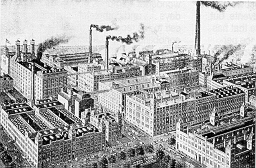
The Germans in New York seem to be the most "advanced"
pleasure-seeking
people on earth. At any rate, they provide more folk festivals in the
course of one year than take
place in all the major cities of Europe in a whole decade. The good folk
s of New York get to enjoy some kind of festival every single day, and
for the most part they all
attend. These festivals last one or several days -- sometimes an entire
week -- and cost a great deal of
time and money. . . . You cannot help but wonder where the
thousands and thousands of working people who attend these festivals get
the time and the money
to pursue so many pleasures [Adolph Wiesner, Geist der
Welt-Literatur,1860. See Conzen, in
Werner Sollors, ed., Invention of Ethnicity (New York, 1989), 24'
ff.].
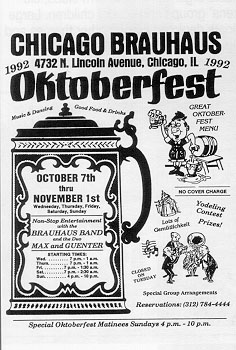
Many simply indulged in "down-home" nostalgic feelings: "The German
felt
revitalized and stimulated. For a few days he was able to feast on the
most wonderful memories of
bygone happy days . . . and completely abandon himself to the reconciling
magnetism of ennobling song" [Leipziger Illustrirte Zeitung (Aug.
5,1855),152. See Conzen, in
Sollors (1989), 255].
Others saw additional benefits hoped for by the Organizers: "These
festivals afforded
Germans in the company of their fellow countrymen the opportunity to
indulge in the old-time
German style and therein acknowledge that their national traditions and
moral fiber were valid even this far away from their original source." At
the same time, the
festivals afforded "the German element the opportunity to depict itself
to Americans from its most
positive angle; German skills, German strength, German education and
German happy ways ought to enter the open marketplace of American
business and civic
activity, and thereby gradually raise them to a higher level of
dedication" [Meyer's Monats-Hefte, 2 (Dec. 1883), 155. See Conzen,
in Sollors (1989),255]. Likewise, the individual leisure-time behavior
of the German-Americans -- the largest ethnic
group in the
country -- could hardly be kept secret. Sunday afternoons in particular
could turn sour, since any
German's innocent hike, if linked to a visit in a beer garden,
bumped straight into the Puritan Yankee tradition of complete Sunday
rest. In 1851 a German
tourist found his countrymen's behavior somewhat offensive, especially on
Sunday:
Then you have the opportunity to observe the sizable number
of Germans in
the larger cities. You meet crowds of them in the streets and in taverns;
however, most are from
the lower classes, while the upper-crust Germans choose either to stay at
home or to head for their summer retreats out in the country. Working
class and trade union
Americans readily follow the example of the Germans in frequenting
taverns, which greatly
annoys the Puritans and most clergymen throughout America. In some German
taverns in and around New York, the ones that are frequented by trade
union and lower class
workers, you even find Sunday afternoons filled with entertaining music
under the pretext of
being religious in nature. Some tavern keepers at times also try to
offer dancing on Sunday afternoons, but the authorities usually catch up
with them-which results
in a fine for the tavern keeper [A. Kirsten, Skizen aus den
Vereinigten Staaten von Nordamerika,
Leipzig, 1851, 315 ff.].
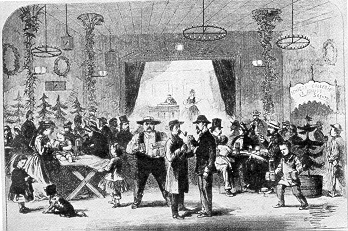
Attempts by Anglos to regulate the public consumption of alcohol
led to social conflict
again and again. It is a fact that the alcohol question repeatedly
crystallized the ethnic
consciousness of German-Americans. They always interpreted prohibition
attempts on the part of
temperance proponents as an attack on their German sense of freedom and
their traditional way of
spending leisure time. A Sunday fling to a beer garden in summer and an
evening of gossip in the
local bari -- in Milwaukee in 1860 there was allegedly one bar for every
30 households -- these traditions were defended as being part and parcel
of German culture
and of American civil rights. When limitations were placed on the sale of
liquor across the bar on
Sundays in Chicago in 1889 and when steep license fees won s
upport in local elections, the Germans opened verbal barrages on the
Sabbath idiocy of
snoopy-nosed Yankee priests." The Illinois Staatszeitung [Sept. 9,
1889] mocked them: "Once
that happens, once deadly boredom and pharisaical hypocrisy are trump,
then
Chicago will have become an authentic American city." Nevertheless,
there were at this juncture
more than 1,700 German taverns in Chicago, and in the red-light district
the tavern and the beer
garden were the most likely contact spots.
In all probability, very few of the contentious defenders of
German-American "freedom"
realized just how much or how little tolerance they themselves exhibited
for cultural
diversity -- although they took for granted as their
God-given right that Anglo-Americans and other ethnic
groups would show them tolerance.
See Theodore Stempfel's 1898
Festschrift, Fifty Years of Unrelenting German Aspirations in
Indianapolis, 1848-1898. Bilingual Edition 1991
(Indianapolis: German-American Center and Indiana German Heritage
Society, 1991),
in particular the speeches on the occasion of the
inauguration of the Deutsches Haus in 1898.



 more than dubious
and,
in general, the observation is valid that these clubs degenerate to
the lowest possible levels of taste. They serve no other purpose than
pleasure, by which, however, they hang onto their
membership. Of course, many of these societies, especially
the musical groups, are a means to greater fellowship and they do build
bridges between
Americans and
Germans. The competitive singing festivals held in the East and the
West are welcome opportunities for good fellowship. . . . The first
attempt
at building an organized network of clubs extending all across the
Union was made by the Turner society, which from its earliest
initiatives showed promise for outstanding results in social and
political matters [Anonymous, "Das deutsche Leben in Amerika,"
Atlantis, Jan. 1857].
more than dubious
and,
in general, the observation is valid that these clubs degenerate to
the lowest possible levels of taste. They serve no other purpose than
pleasure, by which, however, they hang onto their
membership. Of course, many of these societies, especially
the musical groups, are a means to greater fellowship and they do build
bridges between
Americans and
Germans. The competitive singing festivals held in the East and the
West are welcome opportunities for good fellowship. . . . The first
attempt
at building an organized network of clubs extending all across the
Union was made by the Turner society, which from its earliest
initiatives showed promise for outstanding results in social and
political matters [Anonymous, "Das deutsche Leben in Amerika,"
Atlantis, Jan. 1857].




 children onto the gymnastics field. Americans, teachers as
well as
others, can be won over to the cause of German gymnastics only if they
understand fully what's going on. At any rate, the case for our German
culture will be better served if
we attract Americans to our side. On the gymnastics field we can acquaint
them with our German
customs and traditions and, of course, also with our language more
successfully than if we hold them at bay because of our nationalistic
tendency to live in our
own enclaves. If gymnastics is such a good thing, then it is our civic
duty to make it accessible to
Americans as well" [Der Vorbote, July 7, 1886].
children onto the gymnastics field. Americans, teachers as
well as
others, can be won over to the cause of German gymnastics only if they
understand fully what's going on. At any rate, the case for our German
culture will be better served if
we attract Americans to our side. On the gymnastics field we can acquaint
them with our German
customs and traditions and, of course, also with our language more
successfully than if we hold them at bay because of our nationalistic
tendency to live in our
own enclaves. If gymnastics is such a good thing, then it is our civic
duty to make it accessible to
Americans as well" [Der Vorbote, July 7, 1886].







